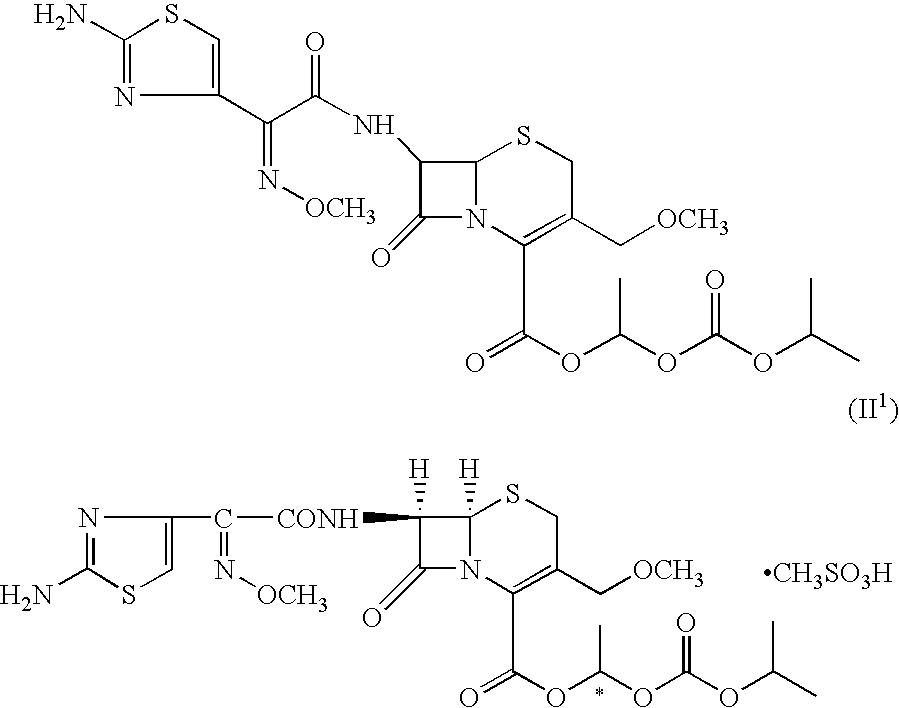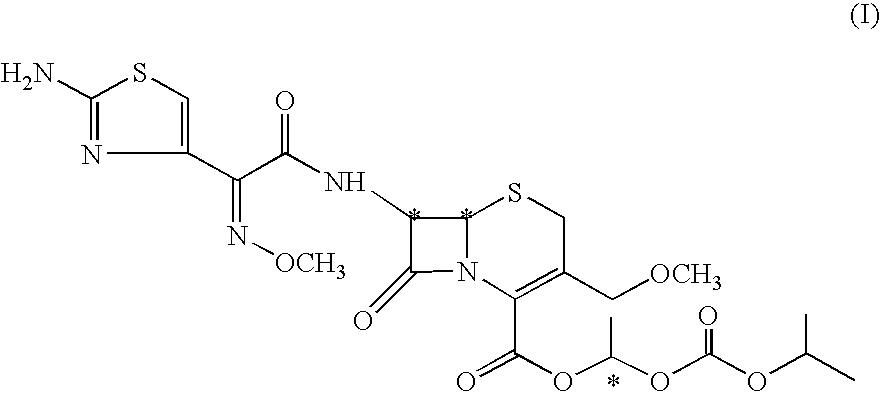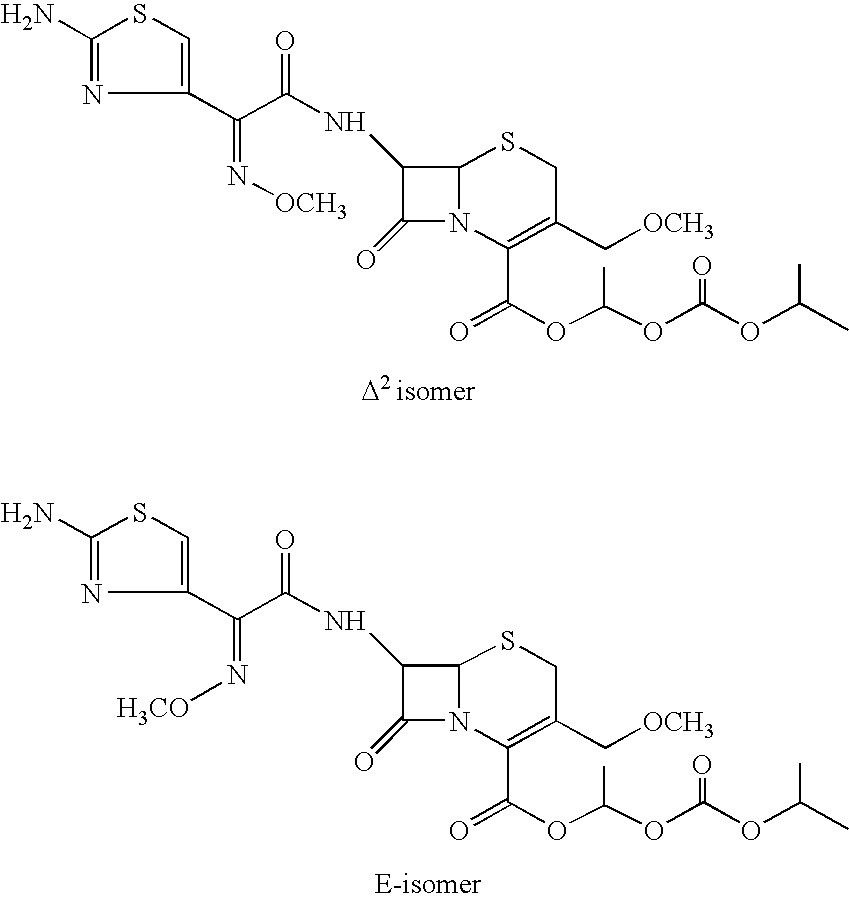Process for the manufacture of cefpodoxime proxetil
a technology of cefpodoxime and proxetil, which is applied in the field of process for the manufacture of cefpodoxime proxetil, can solve the problems of cumbersome methods, inapplicability to industrial scale, and recursive chromatographic methods, and achieves the effect of high purity
- Summary
- Abstract
- Description
- Claims
- Application Information
AI Technical Summary
Benefits of technology
Problems solved by technology
Method used
Image
Examples
example-1
Preparation of Cefpodoxime Proxetil (I):
[0094] Cefpodoxime acid (VI; 50 gms; 0.117 moles) was added to dimethyl acetamide (350 ml) and stirred to get a clear mixture. The mixture was cooled to −6 to −10° C. to which was added 1,8-diazabicyclo[5,4,0]undec-7-ene (DBU) (17.4 gms; 0.114 moles), followed by slow addition of 1-iodoethyl isopropyl carbonate (30.18 gms; 0.117 moles) over a period of 10 to 15 minutes. The reaction mixture was agitated for a period of 20 to 30 minutes at the same temperature. The reaction mixture was quenched by addition of 13% hydrochloric acid. The reaction mixture was further diluted with water (400 ml) and extracted with ethyl acetate (500 ml). The separated aqueous layer was re-extracted with ethyl acetate (500 ml). The organic layers were combined and stirred with 2% sodium carbonate solution (500 ml) at 0 to 5° C. for 30 minutes. The organic layer was washed with 5% sodium thiosulphate solution (500 ml). The organic layer was treated with charcoal (7...
example-2
Preparation of Cefpodoxime Proxetil (I):
[0095] A solution of cefpodoxime acid 25 g (0.058 moles) in dimethyl acetamido (175 ml) was cooled to −10° C. and 1,8 diazobicyclo[5,4,0]undec-7-ene 8.62 g (0.0567 moles) was added dropwise at −10 to −15° C. To this was added 1-iodoethyl isopropyl carbonate 14.5 g (0.0562 moles) dropwise at −10 to −6° C. over 10 minutes. The reaction mixture was stirred for 30 minutes at −10 to −6° C. and quenched by adding hydrochloric acid (5 ml) in de-mineralized water (45 ml) at −10° C.
[0096] The resulting reaction mire was poured into a solution of sodium bicarbonate (7 g) in de-mineralized water (525 ml) and cyclohexane (100 ml) at 0 to 10 (C. A white solid precipitated out which was stirred for 30 minutes and filtered, washed with de-mineralised water (100 ml×3 washes). The resulting slurry was given a wash by cyclohexane (100 ml) and the solid was dried at 40° C. under vacuum to obtain crude cefpodoxime proxetil 25 g (0.0448 moles) in 77% yield havi...
example-3
Preparation of Cefpodoxime Proxetil (I):
[0097] A solution of cefpodoxime acid (50 g, 0.0117 moles) in 350 ml of dimethylacetamide was cooled to −10° C. and 1,8 diazabicyclo[5,4,0]undec-7-ene (17.5 g, 0.0115 moles) was added dropwise at −10 to −15° C. To this was added 1-iodoethyl isopropyl carbonate 28.9 g (0.0112 moles) dropwise at −10 to −6° C. over 10-15 minutes. The reaction mixture was stirred for 30 minutes at −10 to −6° C. and quenched by adding hydrochloric acid (10 ml) in de-mineralized water (90 ml) at −10° C.
[0098] To the resulting reaction mixture 500 ml of ethyl acetate and a solution of sodium dithionate (3 g dissolved in 400 ml of de mineralizes water) was added. The organic layer was separated after 10 minutes stirring. The aqueous layer was extracted with ethyl acetate (500 ml). The combined organic layer was stirred with 2% aqueous sodium bicarbonate (500 ml) solution at 0-5° C. for 30 minutes. The organic layer was separated and washed with 5% aqueous sodium th...
PUM
 Login to View More
Login to View More Abstract
Description
Claims
Application Information
 Login to View More
Login to View More - R&D
- Intellectual Property
- Life Sciences
- Materials
- Tech Scout
- Unparalleled Data Quality
- Higher Quality Content
- 60% Fewer Hallucinations
Browse by: Latest US Patents, China's latest patents, Technical Efficacy Thesaurus, Application Domain, Technology Topic, Popular Technical Reports.
© 2025 PatSnap. All rights reserved.Legal|Privacy policy|Modern Slavery Act Transparency Statement|Sitemap|About US| Contact US: help@patsnap.com



